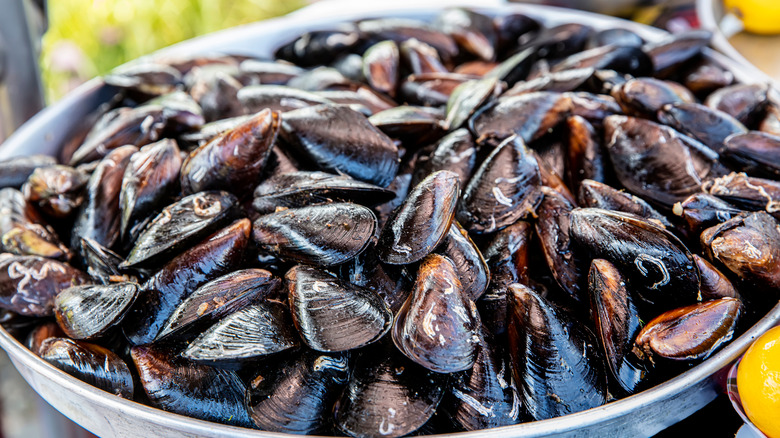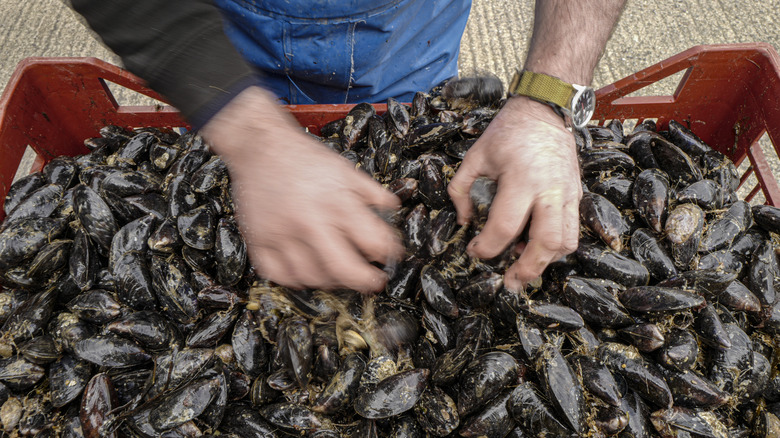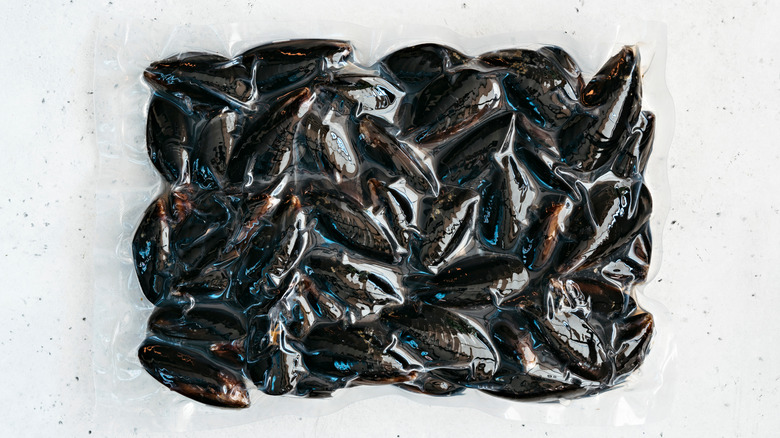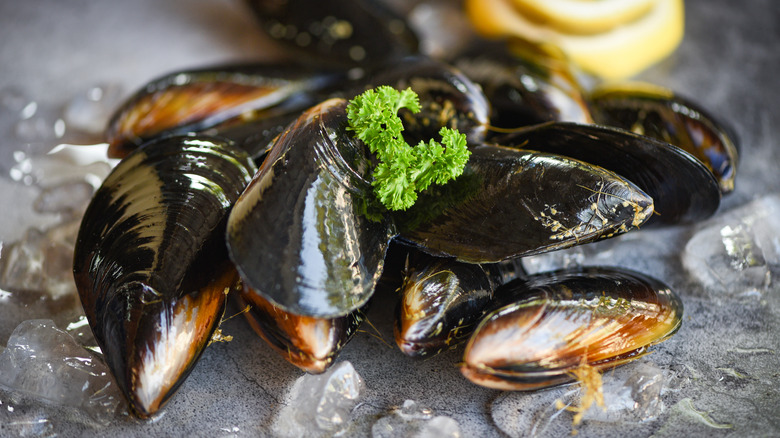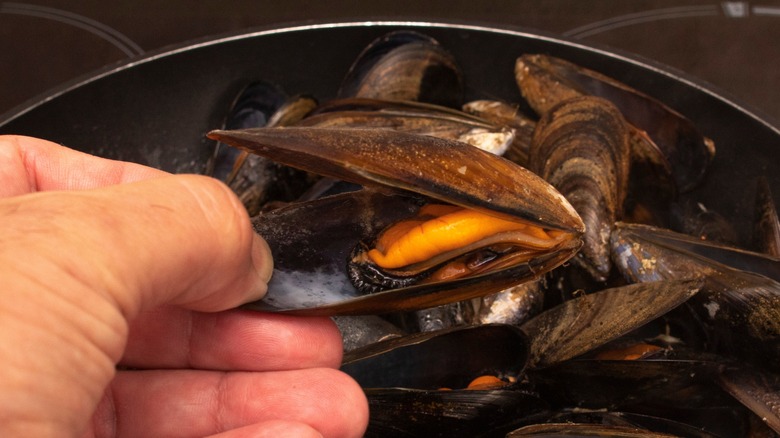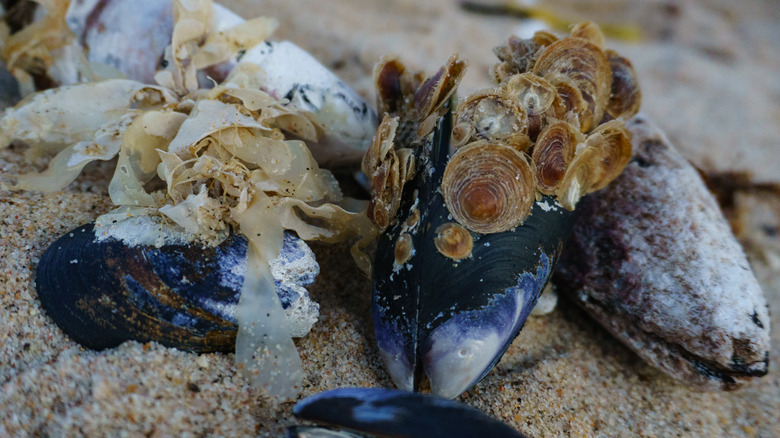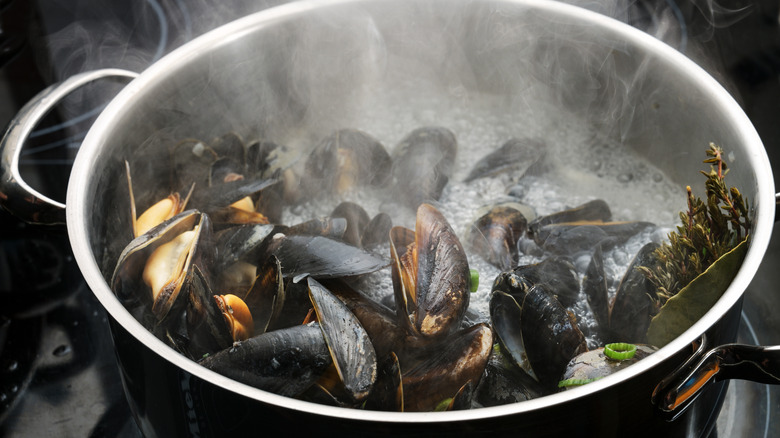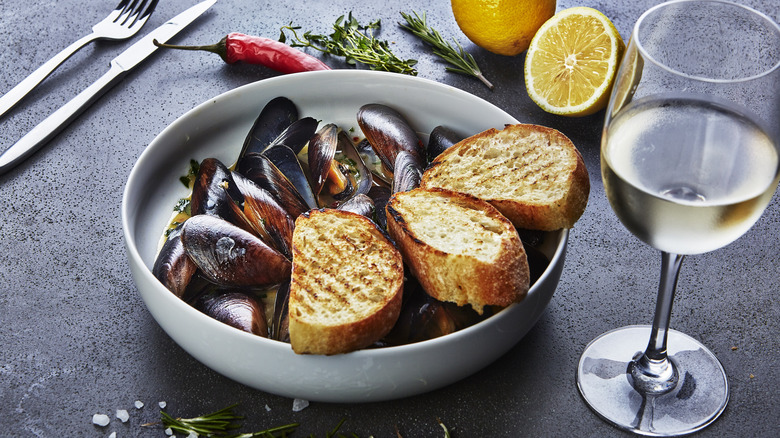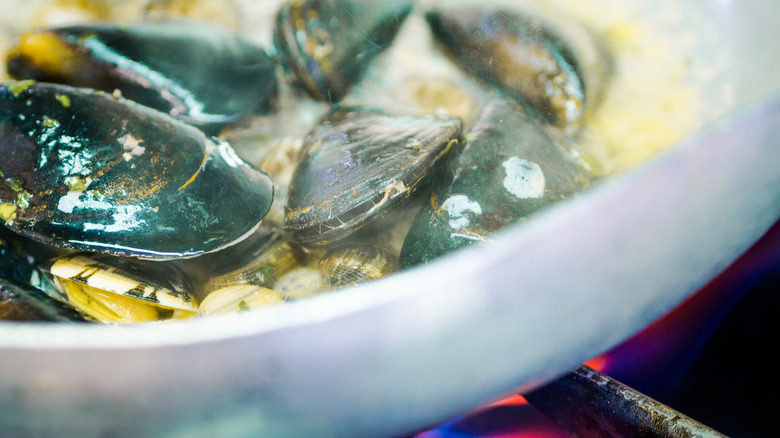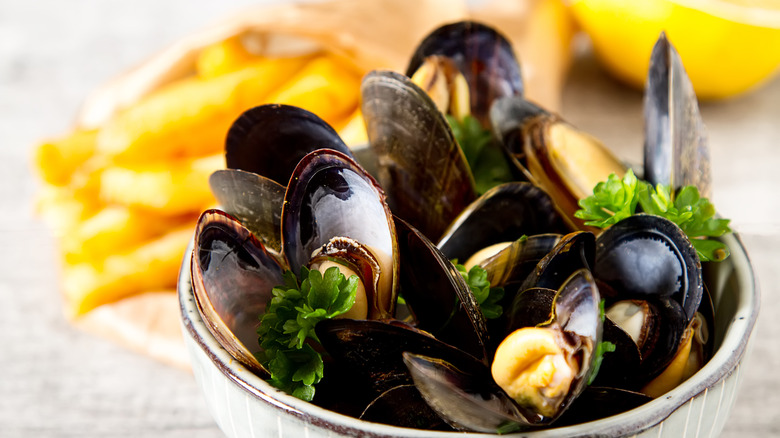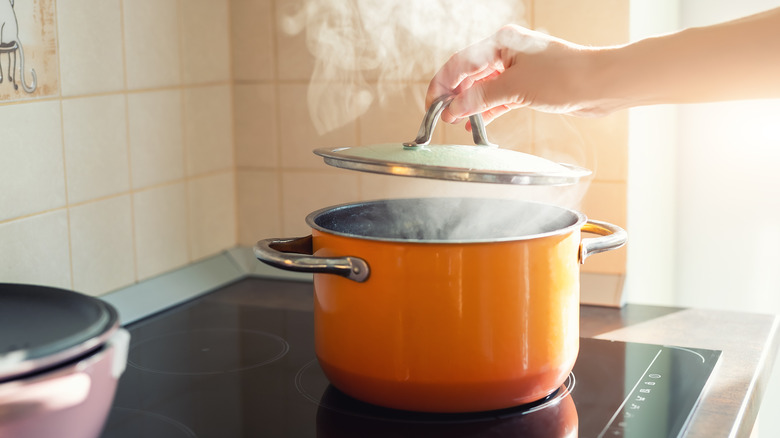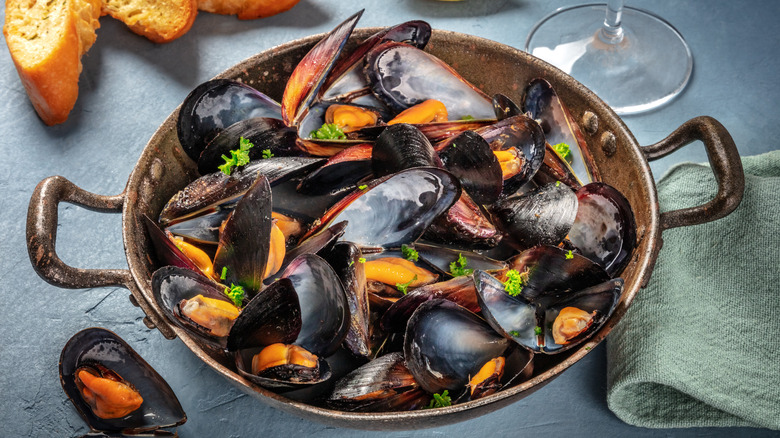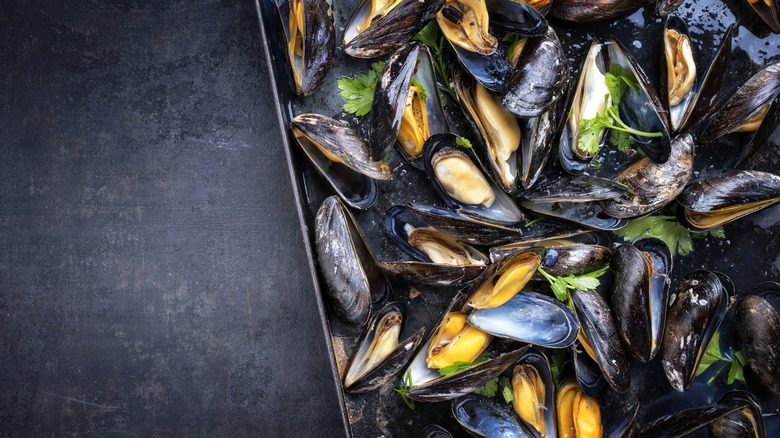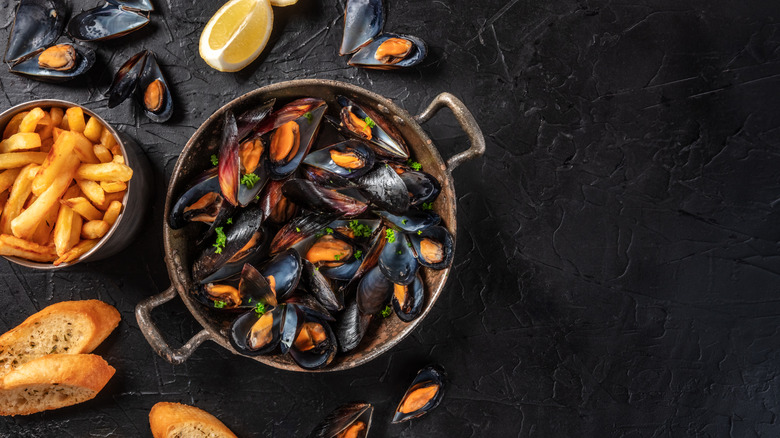Tips You Need When Cooking With Mussels
A lot of home cooks are intimidated by bivalves. After all, clams, oysters, and mussels are kind of mysterious to many of us. We might have eaten them in restaurants, but the rock-like seafood doesn't exactly look easy to prepare. But you might be surprised to find that mussels are actually really, really easy to cook. They only take a few minutes on the stove or on the grill, and they make a breezy summertime snack or main course with very little effort.
If you've never attempted to make mussels at home before, you may not know the basics. That's why we're covering some of the top tips for cooking with mussels. Once you know what to buy and what to expect from the mussel-cooking process, you can head to your local fish market, pick out the freshest mussels there, and come home to make an absolutely mouthwatering meal. Just don't let your friends know how easy they are to make — they'll be impressed by your culinary skills with this seafood favorite.
Without further ado, here are some of the top tips you need when cooking with mussels.
Make sure your mussels smell fresh
According to Pei Mussels, you should only buy fresh (i.e. live) mussels. This means that they can go bad — fast. So, you really want to pay attention to your mussels to ensure that you're not eating anything that's off. Luckily, it's easy to determine whether they're still good to eat or not. It all comes down to giving them a good sniff. If there's something off, you're going to smell it — any hint of funk means that they've gone bad and should be avoided.
What you're looking for is a fresh, briny smell. Essentially, your mussels should smell like the ocean. The smell is more like seaweed than it is like fish, so if you encounter an intense fishiness, that's also a sign that your mussels may have passed their best-by date. While you can keep fresh mussels in your fridge for a day or two, you're generally better off buying your mussels the day you want to cook them. That way, you can feel confident that they're fresh.
Forget about the frozen mussels at the store
Since live mussels can be intimidating for some home cooks, you may be tempted to buy the ones in the frozen section of the grocery store. Sure, these mussels are a lot easier to handle — especially if you just want to throw them in the oven and move on with your life. But according to Bon Appétit, frozen mussels do not make the cut when you take taste into consideration. Generally, they come without the shell, which is half the fun of eating mussels anyway. Plus, buying them frozen usually means there's added food coloring, which is the last thing you want when eating seafood. And the worst part? Freezing mussels ruins their texture, making them way chewier than when cooked fresh.
Instead, you're better off getting fresh mussels at the seafood counter or at your local fishmonger. Yes, they're a little bit trickier to deal with — and you have to keep them alive before you cook them. But the extra hassle is well worth it. The lovely, springy texture of fresh mussels beats the weird, rubbery mouthfeel of the frozen ones any day.
Buy about a pound of mussels per person
If you haven't cooked with mussels much in the past, you may be wondering how many of them to get at the store for your meal. While you may know how much tuna or salmon to grab if you're feeding a crew, you can't use the same numbers for mussels because the shell adds a lot of extra weight. That's why you should follow Food Network's advice: pick up about 1 pound to 1 1/2 pounds of mussels for every person at your dinner table.
Keep in mind that this number is appropriate if you're serving mussels as the main course. But what if you're just using them as a side or a snack before dinner? In that case, you can opt for a lot less — maybe grab 1/2 pound per person. If you do end up grabbing too much, just make sure you refrigerate the leftovers. You can enjoy the mussels the next day, though the texture may not be as good.
Ensure the mussels are closed before you start cooking
Another way to make sure your mussels are as fresh as can be? Before you start cooking, take a close look at your mussels and make sure that every single one is closed. This indicates that the mussel is still alive, and therefore, fresh. Striped Spatula says that they should be closed tightly. But if you come across one that's not closed, you can gently tap it on the counter. After doing so, wait a few minutes to see if the mussel closes on its own. If it doesn't close, then the mussel is probably dead. That means you'll want to throw it away — don't cook a dead mussel.
While you're checking to make sure that all of your mussels are closed, you should also take a close look at the shell. If the shells have cracks or chips in them, that's an indication that the mussel is less than fresh — you can toss those, too.
Clean and debeard your mussels prior to cooking
Once you've inspected all your mussels and made sure they're nice and fresh, it's time to move on to the cleaning process. One thing you should know about preparing mussels is that it takes time to clean them properly. Farm-raised mussels — which are the ones you'll most likely encounter — are less dirty than their wild counterparts, but they still need to be tended to. Since sand and other gunk can end up on the shells, it's important to wash everything off before you place your mussels in the pot.
But it's not just sand and dirt you have to watch out for — you'll also want to remove the mussels' beards. A mussel's beard looks similar to a clump of hair, and you'll find it at the edge of their shell. Though some mussels have already been debearded, you'll want to check and ensure that they're gone. If you have to remove any yourself, firmly grasp the beard and pull it away from the mussel swiftly. Use a knife if you're still struggling to get it off.
Steam your mussels by adding liquid to the pan
If you're looking for an easy way to cook your mussels, try steaming them. It's a super-easy and versatile process that takes no time at all. It makes for a quick, healthy dinner that comes together with very little effort. But what do you need to steam your mussels? According to Bon Appétit, all you have to do is choose a liquid, and add it to your pan.
Of course, you can always stick with the basics and just use water, but that won't impart your mussels with much flavor. You're better off using a more flavorful liquid like coconut milk, fish sauce, or even soy sauce. Beer also makes a great broth. Adding some aromatics, like garlic, onions, and celery, to the pot will add even more flavor to the dish. Bring this liquid to a low simmer before you throw your mussels into the bath.
Cook your mussels in wine
If you really want to make a special dish, use wine as your cooking liquid. When mussels are cooked in a white wine sauce, it's referred to as moules marinières, a light French dish that makes excellent use of bivalves.
According to Simply Recipes, you're going to want to use a dry white wine for this recipe. Forget the Moscato — you're better off using a Sauvignon Blanc. If you want the dish to taste as good as possible, opt for a quality dry white wine that doesn't break the bank. In addition to the white wine, the recipe's sauce also calls for butter (definitely don't skimp on the butter!), shallots, and garlic. You can add other aromatics to the dish if you want to infuse the mussels with even more flavor. This recipe is simple to make, but once you give it a try, you'll understand why it's such a well-regarded classic in French cuisine.
Don't boil your mussels — simmer them
Once you get the liquid in your pan (along with all the other sauce ingredients), it's time to get cooking. There's one very important thing to keep in mind at this point in the process: Mussels are a very delicate food. While a huge hunk of beef can take quite a bit of heat, mussels require a more delicate approach. When applying heat, make sure that you're not absolutely blasting your mussels.
Once the aromatics have been added to the pan, the temperature can run away from you and get hot — fast. If you're cooking mussels at a rolling boil, there's a good chance they'll be overcooked before you realize it. Rather, bring the liquid down to a gentle simmer once you've added your mussels to the pot. That way, your mussels will cook quickly, but not so fast that you end up overcooking them. Make sure to stir your mussels a few times as they cook to ensure they all get the chance to open up properly.
Don't forget to add herbs to your mussels
You've added your aromatics and liquid to the pan, and even thrown in some fat to level up the decadence factor. Now you're well on your way to enjoying a lovely meal of steamed mussels. But wait! You can add another layer of flavor to the dish by chopping up some herbs. While they aren't required to make a delicious meal of mussels, they can add lots of flavor and texture to your dish.
One Martha Stewart recipe for mussels and white wine with herbs calls for thyme and bay leaves in addition to fresh, flat-leaf parsley. But you don't have to stick to the recipe if you have different ingredients in your fridge. You can also pair your mussels with chives, cilantro, basil, and even mint. Don't be afraid to get creative here and add whatever herbs you have on hand — you might be surprised at what you come up with.
Keep the lid on your cooking mussels
While there's more way than one way to make mussels, when you place them into a pot, you're not boiling them — you're steaming them. According to Bon Appétit, using a lid is important when you're cooking mussels this way. As soon as you place your bivalves into the pot, it's time to put a lid on it. (Don't wait until they've already started cooking.) That's the best way to ensure your mussels are cooked all the way through. Don't take the lid off until it's time to give the mussels a quick stir — wait about seven minutes into the cooking process. After stirring, replace the lid until the mussels have finished cooking completely.
Once you're ready to take the lid off for good, be careful: The steam can get quite hot. Make sure to stand back from the stove, and wait before you take a whiff of your creation. Give your mussels some time to cool off before you serve them and start eating.
Stop cooking your mussels when they open
How can you tell when your mussels have finished cooking? Many people have concerns about cooking seafood, so making sure that your mussels are fully-cooked is important. Luckily, it's pretty easy to gauge when they're ready to be enjoyed.
Remember when you checked to make sure that the mussels were all closed as you were cleaning them off and getting them ready for the cooking process? Well, when they're cooked, they'll be fully open, according to BBC Good Food. When you take the lid off your pot, you should make sure that all of your mussels have opened properly. If you notice any that haven't opened, you should throw those away — there's a good chance the mussel is dead. Once you see those shells open, it's time to take your mussels off the stove — keep them on for much longer than that, and you may end up with a rubbery mess.
Try grilling your mussels
Steaming might be one of the quickest and easiest ways to cook mussels, but there are plenty of other methods you can try. If you have a grill, why not try throwing your mussels on there? This is a great option if you're having a cookout and want to offer something other than the standard hamburgers and hot dogs. According to Better Homes and Gardens, making grilled mussels is relatively easy. Clean and prepare your mussels as if you were going to steam them, then get the grill going.
First, you're going to need to grab some foil. Place the foil down on a table, and put the mussels on top. Then, use the foil to cover the mussels and seal the pouch with a double fold. (You're basically making a little pocket to steam the mussels in). Place the mussels on the grill using medium-high heat for around eight minutes, and you'll have a delicious meal in no time. Adding a garlic-herb butter to your grilled mussels will transform them into a sophisticated snack or main course.
Serve your mussels with crusty bread or fries
Now that your mussels are cooked and ready to go, you may be wondering what to pair them with. You can always eat them on their own, but combining them with a carb can make for a filling and complete meal. PEI Mussels suggests pairing your steamed mussels with a crusty bread (think: baguettes, French bread, or even a tangy slice of sourdough). This is a particularly good combo if you're working with lots of boozy broth — it makes for an excellent dipping sauce for your bread.
Want to take your dish to the next level? Opt for some fries on the side for classic moules frites. Crispy, crunchy fries are also delicious when dipped into the mussel broth, and adding a fried element to your meal can feel deliciously decadent. If you've never tasted this combo before, you should definitely give it a try.
